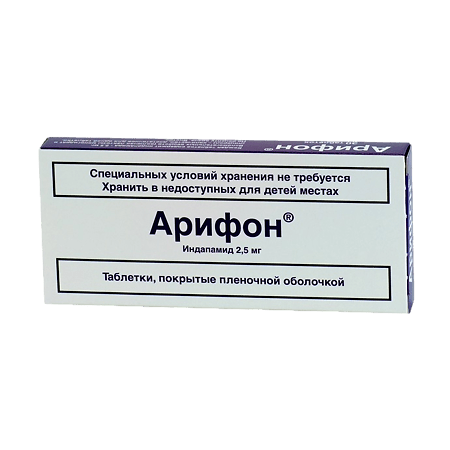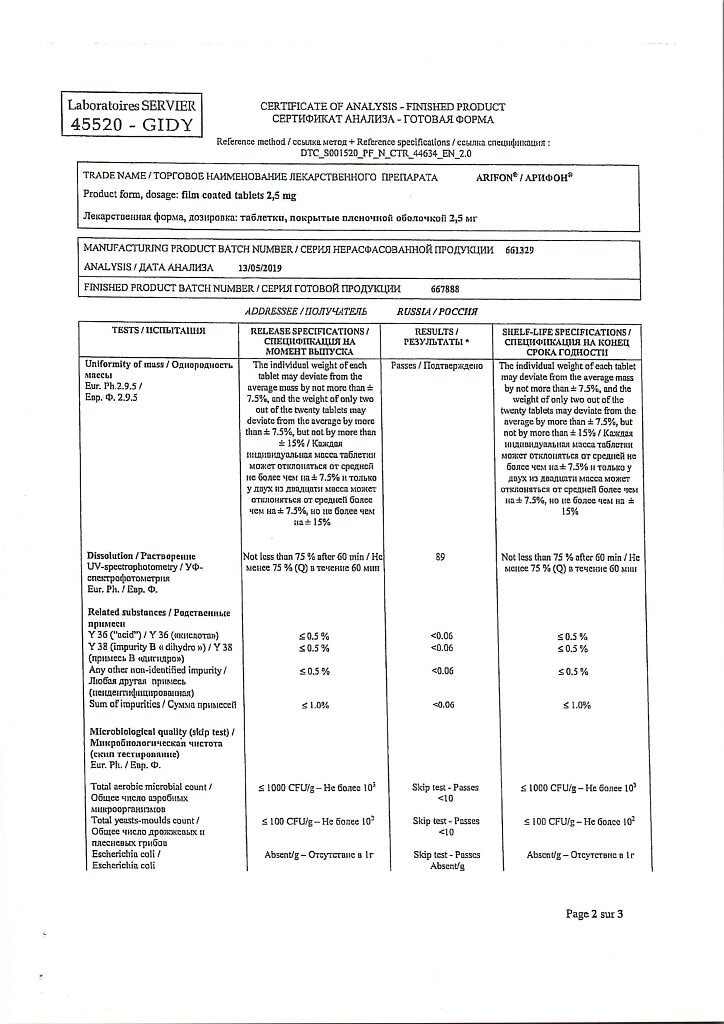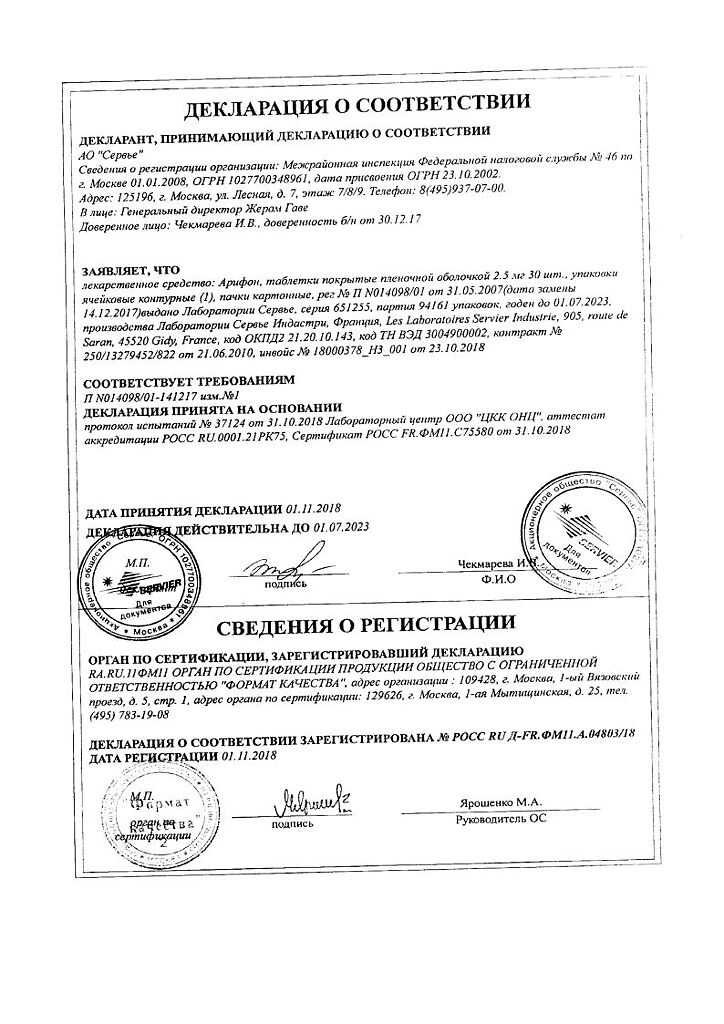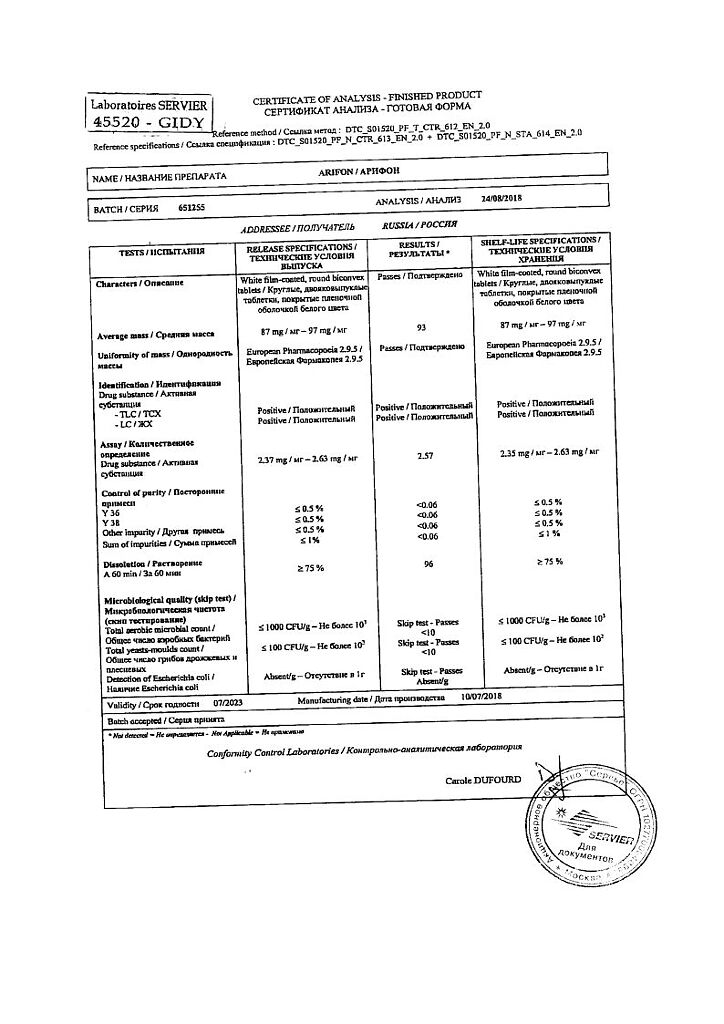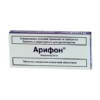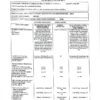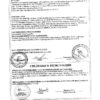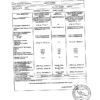No products in the cart.
Arifon, 2,5mg 30 pcs.
€6.22 €5.53
Description
Pharmaceutical group: diuretic agent.
Pharmaceutical action:
Hypotensive agent (diuretic, vasodilator). By pharmacological properties it is close to thiazide diuretics (disruption of Na+ reabsorption in the cortical segment of the Genle loop). Increases urinary excretion of Na+, Cl- and, to a lesser extent, K+ and Mg2+. Having the ability to selectively block “slow” calcium channels, increases the elasticity of arterial walls and reduces RPS. It helps to reduce LV hypertrophy of the heart.
Does not affect plasma lipid levels (TG, LDL, HDL); does not affect carbohydrate metabolism (including in patients with concomitant diabetes). It reduces sensitivity of the vascular wall to noradrenaline and angiotensin II, stimulates the synthesis of PgE2 and prostacyclin PgI2, reduces the production of free and stable oxygen radicals. When administered in high doses, it does not affect the degree of BP reduction, despite the increase in diuresis.
Therapeutic effect is seen in 1-2 weeks after multiple dosing, reaches maximum by 8-12 weeks and lasts up to 8 weeks; after a single dose maximum effect is seen in 24 hours.
Pharmacokinetics:
Fast and complete absorption from the gastrointestinal tract; bioavailability is high. Food intake slightly slows down the absorption rate, but does not affect the final amount of absorbed drug. TCmax is 1-2 hours after taking the usual dosage form and 12 hours after taking the retard tablets. Cmax after an oral dose of 5 mg is 260 ng/ml. When repeated doses are taken, the fluctuations in plasma concentrations between 2 doses are reduced. Css is established after 7 days of regular use.
Binding with plasma proteins is 71-79%. It also binds with elastin of smooth muscles of the vascular wall. It has a high volume of distribution and passes through histohematic barriers (including the placental one).
It is metabolized in the liver. T1/2 is 14 hours, final T1/2 is 26 hours. The drug is excreted by the kidneys 60-70% as metabolites (about 5-7% is excreted unchanged), 20-23% – through the intestines. Pharmacokinetics does not change in patients with renal insufficiency. It does not cumulate.
Indications
Indications
Arterial hypertension.
Pharmacological effect
Pharmacological effect
Pharmaceutical group: diuretic.
Pharmaceutical action:
Antihypertensive agent (diuretic, vasodilator). Its pharmacological properties are similar to thiazide diuretics (impaired Na+ reabsorption in the cortical segment of the loop of Henle). Increases urinary excretion of Na+, Cl- and, to a lesser extent, K+ and Mg2+. Having the ability to selectively block “slow” calcium channels, it increases the elasticity of arterial walls and reduces peripheral vascular resistance. Helps reduce LV hypertrophy of the heart.
Does not affect plasma lipid levels (TG, LDL, HDL); does not affect carbohydrate metabolism (including in patients with concomitant diabetes mellitus). Reduces the sensitivity of the vascular wall to norepinephrine and angiotensin II, stimulates the synthesis of PgE2 and prostacyclin PgI2, reduces the production of free and stable oxygen radicals. When prescribed in high doses, it does not affect the degree of reduction in blood pressure, despite an increase in diuresis.
After repeated administration, the therapeutic effect is observed after 1-2 weeks, reaches a maximum at 8-12 weeks and lasts up to 8 weeks; after taking a single dose, the maximum effect is observed after 24 hours.
Pharmacokinetics:
Quickly and completely absorbed from the gastrointestinal tract; bioavailability is high. Eating slightly slows down the rate of absorption, but does not affect the final amount of the drug absorbed. TCmax – 1-2 hours after taking the usual dosage form and 12 hours after taking retard tablets. Cmax after oral administration at a dose of 5 mg is 260 ng/ml. With repeated doses, fluctuations in plasma concentrations of the drug in the interval between 2 doses decrease. Css is established after 7 days of regular use.
Communication with plasma proteins – 71-79%. It also binds to elastin of smooth muscles of the vascular wall. It has a high volume of distribution and passes through histohematic barriers (including placental).
Metabolized in the liver. T1/2 – 14 hours, final T1/2 – 26 hours. 60-70% is excreted by the kidneys in the form of metabolites (about 5-7% is excreted unchanged), through the intestines – 20-23%. In patients with renal failure, pharmacokinetics do not change. Does not cumulate.
Special instructions
Special instructions
When prescribing Arifon to patients with diabetes, it is extremely important to control glucose levels, especially in the presence of hypokalemia.
Patients with elevated uric acid levels tend to have more gout attacks.
When thiazide diuretics are prescribed to patients with liver failure, hepatic encephalopathy may develop. In such cases, the drug should be stopped immediately.
Thiazide diuretics are fully effective only in the absence of impairment or moderate impairment of renal function (blood creatinine less than 25 mg/l or 220 µmol/l).
In elderly patients, the normal level of creatinine in blood plasma is calculated taking into account the age, body weight and gender of the patient using the Cockcroft formula:
ClCR=(140-age /in years/) x body weight (kg)/0.814 x plasma creatinine (µmol/l).
This formula is used to calculate creatinine levels in men; for women, the final result should be multiplied by 0.85.
It should be taken into account that at the beginning of treatment, patients may experience a decrease in glomerular filtration due to hypovolemia, which is caused by the loss of water and sodium ions while taking diuretics. As a result, the concentration of urea and creatinine in the blood plasma may increase. If kidney function is not impaired, such temporary renal failure usually resolves without consequences. However, with existing renal failure, the patient’s condition may worsen.
During therapy with Arifon, exacerbation of disseminated lupus erythematosus is possible.
Before starting treatment, the content of sodium ions in the blood plasma should be determined. During treatment, regular monitoring of this indicator is necessary, since initially a decrease in sodium concentration in the blood plasma may not be accompanied by the appearance of pathological symptoms. This analysis should be performed especially often in patients with liver cirrhosis and in the elderly.
When treating with thiazide diuretics, the main risk is a sharp decrease in the content of potassium ions and the development of hypokalemia. In a certain category of patients, especially the elderly, debilitated or receiving concomitant therapy, with cirrhosis of the liver with developed edema or ascites, coronary artery disease, chronic heart failure, it is necessary to avoid the development of hypokalemia (Hypokalemia, like bradycardia, is a condition that contributes to the development of severe cardiac arrhythmias, especially the “pirouette” type, often leading to death. In all the cases described above, it is necessary more often determine the content of potassium ions in the blood plasma. The first measurement of the concentration of potassium ions in the blood should be carried out within the first week from the start of treatment.
If hypokalemia occurs, appropriate treatment should be prescribed, while avoiding the use of drugs that cause pirouette-type arrhythmias. If such a rhythm disturbance occurs, antiarrhythmic drugs should not be used, but an artificial pacemaker should be installed.
It should be borne in mind that thiazide diuretics may reduce the excretion of calcium ions in the urine, resulting in mild and temporary hypercalcemia. Severe hypercalcemia may be a consequence of previously undiagnosed hyperparathyroidism.
Diuretics should be discontinued before starting a study of parathyroid function.
If it is necessary to prescribe laxatives during Arifon therapy, drugs that do not affect intestinal motility should be prescribed.
While taking indapamide, a positive result is possible during doping control for athletes.
Increasing the dose of thiazide diuretics above the optimal one is not accompanied by an increase in antihypertensive effect, but may be accompanied by the occurrence of severe adverse reactions. If therapy with thiazide diuretics does not lead to the desired therapeutic effect, the dose of the drug should not be increased.
When used simultaneously with other antihypertensive drugs, the dose of Arifon should be reduced, at least at the beginning of treatment.
Use in pediatrics
Due to the lack of sufficient clinical data, the drug is not recommended for use in children and adolescents under 18 years of age.
Impact on the ability to drive vehicles and operate machinery
The action of the substances included in Arifon does not lead to disruption of psychomotor reactions. However, it should be borne in mind that in some cases, when blood pressure decreases, individual reactions may occur (especially at the beginning of therapy or when combining several antihypertensive drugs). In this case, the ability to perform work that requires increased attention and speed of psychomotor reactions may be reduced.
Active ingredient
Active ingredient
Indapamide
Composition
Composition
1 tablet contains:
Active substance:
indapamide 2.5 mg;
Excipients:
lactose monohydrate – 59.25 mg;
corn starch – 20.00 mg;
magnesium stearate – 0.75 mg;
povidone – 4.00 mg;
talc – 3.5 mg;
Film casing:
glycerol – 0.087 mg; macrogol 6000 – 0.035 mg; magnesium stearate – 0.087 mg; hypromellose – 1.449 mg; sodium lauryl sulfate – 0.017 mg; titanium dioxide – 0.278 mg; white beeswax – 0.047 mg.
Pregnancy
Pregnancy
As a rule, Arifon is not recommended for use during pregnancy, incl. to relieve physiological edema. It should be borne in mind that diuretics can cause fetoplacental ischemia and lead to impaired fetal development.
Due to the fact that indapamide is excreted in breast milk, it is also not recommended to prescribe the drug during breastfeeding. If therapy is necessary, breastfeeding should be stopped.
Contraindications
Contraindications
hepatic encephalopathy;
severe renal failure;
hypokalemia;
hypersensitivity to sulfonamide derivatives.
The simultaneous use of Arifon and drugs that prolong the QT interval should be avoided.
Interaction
Interaction
With the simultaneous use of indapamide and tricyclic antidepressants such as imipramine, an increased hypotensive effect and an increased risk of developing orthostatic hypotension are observed.
With the simultaneous use of thiazide diuretics and calcium salts, hypercalcemia may develop due to a decrease in the excretion of calcium ions in the urine. With the simultaneous use of indapamide and cyclosporine, an increase in the content of creatinine in the blood plasma is possible, which is observed even with normal levels of water and sodium ions. With the simultaneous use of thiazide diuretics and lithium preparations, an increase in the concentration of lithium in the blood plasma is possible, accompanied by the appearance of signs of overdose (due to a decrease in the excretion of lithium in the urine).
If it is necessary to prescribe this combination, the concentration of lithium in the blood plasma should be monitored. With the simultaneous use of diuretics with astemizole, bepridil, erythromycin (iv), halofantrine, pentamidine, sultopride, terfenadine, vincamine, the likelihood of pirouette-type arrhythmia increases. Hypokalemia, bradycardia, or prolonged QT interval may contribute to this condition.
When used simultaneously with cardiac glycosides, the toxic effect of the latter may be enhanced (it is necessary to monitor the level of potassium in the blood plasma and ECG readings). When used simultaneously with NSAIDs (for systemic use), high doses of salicylates may reduce the hypotensive effect of indapamide.
With significant fluid loss, acute renal failure may develop (due to a sharp decrease in glomerular filtration). If it is necessary to prescribe NSAIDs during Arifon therapy, the loss of water should be compensated and renal function should be carefully monitored. When using indapamide simultaneously with other drugs that can cause hypokalemia, incl. with amphotericin B (iv), gluco- and mineralocorticoids (with systemic use), tetracosactide, laxatives that stimulate intestinal motility, the risk of hypokalemia increases (constant monitoring of the level of potassium in the blood plasma and, if necessary, appropriate treatment is required).
With the simultaneous use of thiazide diuretics with GCS, tetracosactide for systemic use, a decrease in the hypotensive effect is observed due to the retention of water and sodium ions under the influence of GCS. With simultaneous use of indapamide with baclofen, an increase in the hypotensive effect is observed (it is necessary to compensate for the loss of water and carefully monitor renal function at the beginning of treatment). With the simultaneous use of indapamide and potassium-sparing diuretics (including amiloride, spironolactone, triamterene), the possibility of developing hypokalemia or hyperkalemia cannot be completely excluded, especially in patients with diabetes mellitus and renal failure.
In such cases, the level of potassium in the blood plasma, ECG parameters should be monitored and, if necessary, therapy should be adjusted. When indapamide is used concomitantly with ACE inhibitors, hyponatremia in patients receiving ACE inhibitors increases the risk of sudden arterial hypotension and/or acute renal failure (especially with renal artery stenosis). Patients with essential arterial hypertension and a reduced content of sodium ions in the blood plasma due to diuretics should stop taking diuretics 3 days before starting treatment with ACE inhibitors.
In the future, if necessary, resume taking diuretics. In addition, low, gradually increasing doses of ACE inhibitors are prescribed. In chronic heart failure, treatment should begin with low doses of ACE inhibitors, after first reducing the dose of diuretics. In all cases, in the first week of taking ACE inhibitors, it is necessary to monitor renal function (plasma creatinine content).
With the simultaneous administration of indapamide and antiarrhythmic drugs that can cause pirouette-type arrhythmias (including quinidine, hydroquinidine, disopyramide, amiodarone, bretylium, sotalol), the risk of developing this condition increases (especially against the background of hypokalemia, bradycardia, and an initially prolonged QT interval). If it is necessary to prescribe this combination, the level of potassium in the blood plasma and the QT interval should be monitored, adjusting the dosage regimen.
With the simultaneous use of diuretics and metformin, the appearance of lactic acidosis is possible, which is apparently associated with the development of functional renal failure caused by the action of diuretics (mostly “loop”). It is not recommended to use metformin in combination with Arifon when the creatinine level is more than 15 mg/l (135 µmol/l) in men and 12 mg/l (110 µmol/l) in women.
When using iodine-containing X-ray contrast agents, it should be borne in mind that the diuretic effect of indapamide increases the risk of developing renal failure. This risk is especially high when using iodinated contrast agents in high doses. Before using iodine-containing radiocontrast agents, patients need to restore fluid loss.
Overdose
Overdose
Symptoms: possible disturbances in water and electrolyte balance (hyponatremia, hypokalemia), nausea, vomiting, arterial hypotension, convulsions, dizziness, drowsiness, confusion, polyuria or oliguria ending in anuria (due to hypovolemia).
Treatment: urgent measures aimed at removing the drug from the body: lavage of the gastrointestinal tract and/or administration of activated carbon, followed by restoration of normal water and electrolyte balance.
Storage conditions
Storage conditions
The drug should be stored in a dry place at a temperature not exceeding 30°C.
Shelf life
Shelf life
5 years
Manufacturer
Manufacturer
Servier Industry Laboratories, France
Additional information
| Shelf life | 5 years |
|---|---|
| Conditions of storage | The drug should be stored in a dry place at a temperature not exceeding 30°C. |
| Manufacturer | Servier Rus LLC, Russia |
| Medication form | pills |
| Brand | Servier Rus LLC |
Related products
Buy Arifon, 2,5mg 30 pcs. with delivery to USA, UK, Europe and over 120 other countries.

